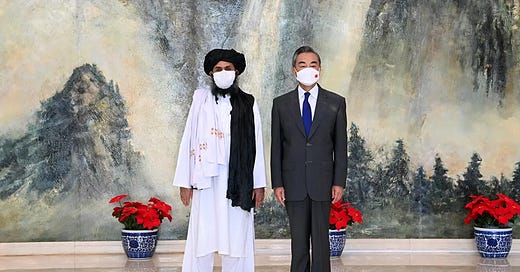AFGHANISTAN: A SPECULATIVE ASSESSMENT OF ITS POTENTIAL FUTURE
The withdrawal of Western influence from Afghanistan had at first shocked then surprised the world. Though the transition to the new government was not without problems the Taliban began displaying a very new face to the world.
China, Russia and Iran along with Turkey were the quickest to respond to the new reality presenting itself in Afghanistan. Pakistan too was hard on their heels. The western alliance of states, still licking their wounds, were much tardier in their responses, careful to avoid any sign of support and couching their words with veiled threats and warnings and often with barely concealed insults.
Soon, however, it was clear that the new Taliban had learned well the mistakes of their predecessors. The new government that had been formed was composed of all the main elements which talked for each stakeholder grouping across the wide and mountainous expanse of the nation.
China was seen from the earliest days of the founding of the new Afghan government to be by far the greatest contributor to and supporter of Afghanistan. Offers of investment, training and all forms of helpful advice and expertise emanated from China and were eagerly welcomed by the new Afghan authorities.
Slowly but surely bridges to many nations began to be built and ever-greater trust was established. A flourishing of trade and foreign investment was seen to be taking place which galvanized many elements within Afghan society that had previously been fearful and doubtful regarding the new era that had so recently and speedily arrived.
As the USA muttered to itself in angst, anger, doubt and the usual confusion of ignorance with which it viewed geopolitical events, the core group of nations in the vicinity of Afghanistan got to work helping the nation establish long-sought stability. IS-K, who had made the evacuation from Kabul even more nightmarish than need be, were isolated and driven out by a combination of Afghan forces and the oversight of neighbouring nations.
As speedily as the Taliban had reestablished their dominance the few months following their victory brought one gain after another for a nation previously experiencing a constant drop from one pernicious level to another. Of course, the West looked on with jaundiced eyes. There was no propaganda gain for them in an Afghanistan that was lifting itself up when the hope among western elites was that it would plunge ever further downward, easing their shame and humiliation somewhat.
Those most knowledgeable concerning Afghanistan’s past were brought to the fore to give their advice to those taking up the reins of governance. Solid and uncorrupted institutions were formed mirroring those that had existed in the time of the king until the fateful year of 1973 when he was deposed in a coup.
The Taliban leadership including those who had acted for it as diplomats during the Doha negotiations soon displayed a high level of sensitivity regarding the views of both country and urban dwellers alike. Consultations with all interest groups took place soon after the new government was announced. These took place within the traditional jirga system with both simite (consultation with elders and tribal chiefs) and sabhā (rural council) forms becoming ubiquitous across Afghanistan. In this way, a national consensus was formed. Over time this enabled a high degree of legitimacy to become established for the new government, the bureaucracy and the Afghan military.
With the binding of the nation through the methods outlined above a largely successful attempt was made to regain the stability seen during the reign of the king, Mohammed Zahir Shah from 8 November 1933 to 17 July 1973. Though some problems continued to exist, some of which were eventually laid at the door of the hated western powers, a good foundation had been laid for a strong advance by the Afghan people in the years to come.




